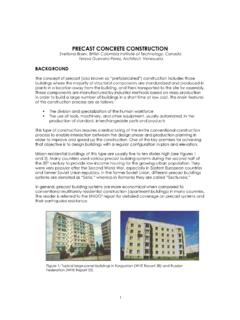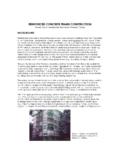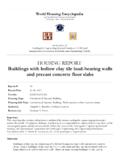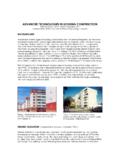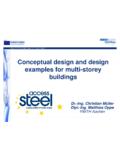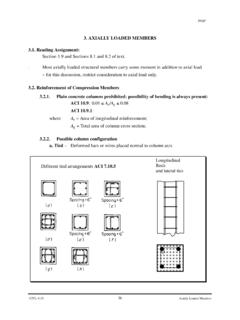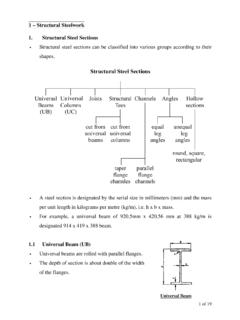Transcription of REINFORCED CONCRETE FRAME CONSTRUCTION
1 REINFORCED CONCRETE FRAME CONSTRUCTIONA hmet Yakut, Middle East Technical University, TurkeyBACKGROUNDR einforced CONCRETE is one of the most widely used modern building materials. CONCRETE is artificial stone obtained by mixing cement, sand, and aggregates with water. Fresh CONCRETE can be molded into almost any shape, which is an inherent advantage over other materials. CONCRETE became very popular after the invention of Portland cement in 9th century; however, its limited tension resistance prevented its wide use in building CONSTRUCTION . To overcome this weakness, steel bars are embedded in CONCRETE to form a composite material called REINFORCED CONCRETE . Developments in the modern REINFORCED CONCRETE design and CONSTRUCTION practice were pioneered by European engineers in the late 9th century. At the present time, REINFORCED CONCRETE is extensively used in a wide variety of engineering applications ( , buildings, bridges, dams).
2 The worldwide use of REINFORCED CONCRETE CONSTRUCTION stems from the wide availability of reinforcing steel as well as the CONCRETE ingredients. Unlike steel, CONCRETE production does not require expensive manufacturing mills. CONCRETE CONSTRUCTION , does, however, require a certain level of technology, expertise, and workmanship, particularly in the field during CONSTRUCTION . In some cases, single-family houses or simple low-rise residential buildings are constructed without any engineering assistance. The extensive use of REINFORCED CONCRETE CONSTRUCTION , especially in developing countries, is due to its relatively low cost compared to other materials such as steel. The cost of CONSTRUCTION changes with the region and strongly depends on the local practice. As an example, a unit area of a typical residential building made with REINFORCED CONCRETE costs approximately US$100 /m2 in India, US$250/m2 in Turkey, and US$500/m2 in the rapid growth of urban population in both the developing and the industrialized countries, REINFORCED CONCRETE has become a material of choice for residential CONSTRUCTION .
3 Unfortunately, in many cases there is not the necessary level of expertise in design and CONSTRUCTION . Design applications range from single-family buildings in countries like Algeria and Colombia to high-rises in Chile, Canada, Turkey, and China (Figure 1). Frequently, REINFORCED CONCRETE CONSTRUCTION is used in regions of high seismic Figure 1: Typical residential RC FRAME building in Turkey (WHE Report 64, Turkey)2 REINFORCED CONCRETE FRAME Constructionrisk, such as Latin America, southern Europe, North Africa, the Middle East, and Southeast Asia. REINFORCED CONCRETE FRAME BUILDINGS REINFORCED CONCRETE (RC) frames consist of horizontal elements (beams) and vertical elements (columns) connected by rigid joints. These structures are cast monolithically that is, beams and columns are cast in a single operation in order to act in unison. RC frames provide resistance to both gravity and lateral loads through bending in beams and columns (Figure 2).
4 There are several subtypes of RC FRAME CONSTRUCTION : onductile RC frames with/without infill walls onductile RC frames with REINFORCED infill walls Ductile RC frames with/without infill walls The current WHE database includes over twenty reports describing RC FRAME CONSTRUCTION . The most prevalent type is RC FRAME with masonry infill walls (Figure 3). This CONSTRUCTION is still practiced extensively in many parts of the world, especially in developing countries. This CONSTRUCTION comprises approximately 75% of the building stock in Turkey, about 60% in Colombia, and over 30% in Greece. Details of this CONSTRUCTION type including regional variations are contained in the WHE reports from Cyprus (WHE Report 13), India (WHE Report 19), Palestinian Territories (WHE Report 48), Turkey (WHE Report 64), and Romania (WHE Report 71). RC frames with CONCRETE infill walls, also known as dual systems, are very common in earthquake-prone areas.
5 The WHE reports from Chile (Report 6) and Syria (Report 59) describe details of this CONSTRUCTION type. Code requirements related to design and detailing of RC FRAME buildings in seismic zones were significantly changed in the early 1970s. Earlier codes focused on the strength requirements that is, on providing adequate strength in structural members to resist the lateral seismic forces. However, based on research evidence and lessons learned from earthquakes in the early 1970s, code requirements have become more focused on the proportioning and detailing of beams, columns, and joints with the objective to achieve a certain amount of ductility in addition to the required strength. Ductility is one Figure 2: A plan of a typical RC FRAME building in Ahmedabad, India; note the portion that collapsed in the 2001 Bhuj earthquake (WHE Report 19, India) REINFORCED CONCRETE FRAME CONSTRUCTION 3of the key features required for desirable seismic behavior of building structures.
6 It can be defined as the ability of a material to stretch (deform) significantly before failure. Steel (and some other metals) exhibit ductile behavior. For example, a metal paper clip can be bent back and forth without breaking. However, other materials are brittle (the opposite of ductile). A piece of chalk will break as soon as we try to bend it. In REINFORCED CONCRETE , CONCRETE behaves like chalk, whereas steel reinforcement behaves like a paper clip. Therefore, steel reinforcement has a key role in ensuring ductile behavior of REINFORCED CONCRETE structures in earthquakes. Earthquake engineers spend a considerable amount of time trying to ensure that the amount and distribution of steel reinforcement are adequate for a specific design. That part of seismic design is called seismic detailing, or sometimes the art of detailing. The principles and rules of seismic detailing of REINFORCED CONCRETE structures have been emerging over time and are mainly reflected in seismic provisions of building codes.
7 Thus, pre-1970 nonductile CONCRETE frames, although often designed to resist lateral forces, did not incorporate modern ductile seismic detailing provisions. As a result, the main seismic deficiencies of the pre-1970s CONCRETE FRAME CONSTRUCTION include (ATC-40 ): Inadequate column detailing. The two main detailing problems include inadequate column lap splices for main flexural reinforcement and a lack of adequate transverse reinforcement (ties) within the column (Figure 4). As an example, column lap splices were typically placed just above the floor level in the zone of high stresses. In addition, the column lap splices were generally too short, often in the order of 30-bar diameters, or less, and were typically not confined with closely spaced column ties (as required by modern codes). Lack of strong column/weak beam design approach. A capacity design approach was not followed in the design of the beam flexural reinforcement, as the beams were generally designed for the code level forces.
8 The effects of post-yield behavior were not considered, thus increasing the chances for undesirable shear failure in either the beams or columns. Shear failure is rather brittle and sudden, and should be avoided in REINFORCED CONCRETE structures located in seismic zones. Inadequate anchorage of beam reinforcement. The top reinforcing bars in beams were often terminated 6 to 8 feet away from the column face, whereas the bottom bars were typically discontinued at the face of the supporting column or provided with only a short lap-splice centered on the column. Excessive tie-spacing. Spacing of ties in beams and columns was excessively large by today s standards. Column ties often consisted of a single hoop with 90 degree hooks spaced at 12 to 18 inches on center. Today s ties generally require 135 degree hooks to ensure adequate confinement. Beam ties, often sized only for gravity shear loads, were spaced closely near the column face but were widely spaced or even discontinued throughout the mid-span region of the beam.
9 Inadequate beam/column joint ties. The lack of ties in the beam/column joint created a weak zone and likely failure mechanism within the joint. REINFORCED CONCRETE FRAME ConstructionSEISMIC PERFORMANCEE arthquake performance of RC FRAME CONSTRUCTION has been well documented. Damage patterns in REINFORCED CONCRETE frames during the 1971 San Fernando (California) earthquake have been extensively studied. More recently, several destructive earthquakes of the last decade, including the 1999 Athens (Greece) earthquake, the 1999 zmit and D zce earthquakes (Turkey), 1999 Chi Chi (Taiwan) earthquake, 2001 Bhuj (India) earthquake, and the 2003 Boumerdes (Algeria) earthquake, have caused substantial damage to RC FRAME CONSTRUCTION . These earthquakes have revealed the following patterns of damages and failures in RC FRAME CONSTRUCTION : Shear failure and CONCRETE crushing failure in CONCRETE columns.
10 These are the most undesirable nonductile modes of failure (Figure 5). This behavior can lead to the loss of gravity load-bearing capacity in the columns and potentially a total building 4: Features of nonductile RC FRAME CONSTRUCTION in Taiwan (WHE Report 61)Figure 3: RC FRAME CONSTRUCTION with hollow- clay tile masonry infill in Algeria (Credit: S. Brzev) REINFORCED CONCRETE FRAME CONSTRUCTION 5 Partial ductile design and detailing. Systems that exhibit some (limited) yielding behavior can eventually form dangerous collapse mechanisms as a result of stiffness or strength degradation at sections without ductile detailing. Conceptual design deficiencies. This includes such deficiencies as incomplete load path and architectural planning deficiencies such as vertical and/or horizontal irregularities. Architectural features play an important role in the performance of RC FRAME buildings.
